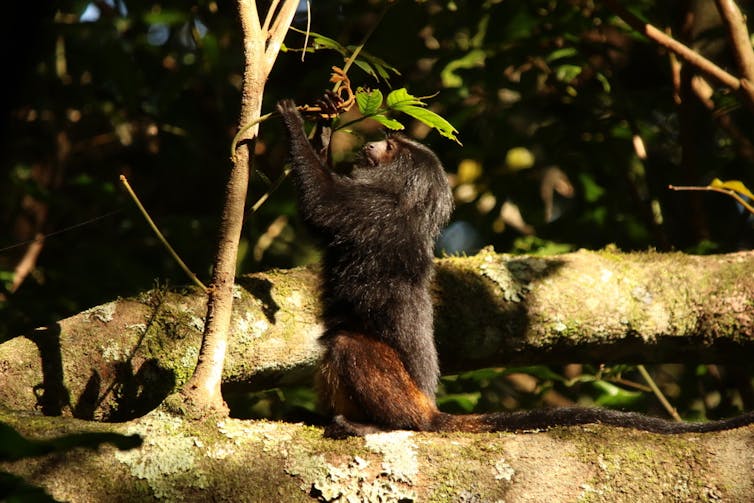
Olivier Kaisin, Université de Liège
Have you ever seen your cat or dog eating grass? They do so because it can help their digestion, and many wild species use natural substances to prevent and control diseases or to repel parasites. This is called “zoopharmacognosy” or, more commonly, animal self-medication.
This practice, which can have prophylactic (intended to prevent disease) or therapeutic (intended to heal it) functions, includes a wide variety of behaviours, such as the consumption of medicinal plants, soil, or the application of substances to the body. For example, many species consume dirt to acquire essential minerals and also facilitate digestion. In mammals, zoopharmacognosy has been observed in elephants, bears, elk and several carnivore species, and it’s especially well known in primates.
At the Laboratory of Primatology of the State University of São Paulo (UNESP) in Brazil, our team studies the behavioural ecology of the black lion tamarin (Leontopithecus chrysopygus), also known as the golden-rumped tamarin. This is a small neotropical primate, endemic to the Brazilian Atlantic forest and currently threatened with extinction.
One part of this project, which is the subject of my PhD, focuses on the study of the physiological and behavioural responses of tamarins to fragmentation and decline in habitat quality.
An expedition to Brazil
In the field, we follow several groups of tamarins within fragments of the Atlantic forest to collect behavioural data and faecal samples for subsequent hormonal analysis. Typically, we woke up at dawn and followed the tamarins from the time they left their sleeping site until they returned to sleep, a little before sunset.
During one of these daily studies, we observed them rubbing their bodies on the trunk of a tree covered with resin. At first we thought that the tamarins were marking their territory, a behaviour that is common in this species. But we soon realised that it was something else. In fact, the individuals in the group were collectively rubbing the area of the trunk from which the resin emanated and were also coating their fur with it. Our first instinct was to record the scene and take samples of the bark and resin to identify the essence of the tree.
When we took the bark sample back to the family that was hosting us during our field campaigns, the hostess immediately recognised the peculiar smell of this tree, which the locals call cabreúva. Indeed, the resin produced has a very woody scent with tones of cinnamon, clove, honey and pine. Our botanical expert later confirmed that it was a species of cabreúva, Myroxylon peruiferum, a tree well known in traditional medicine for its antibiotic, anti-inflammatory and anti-parasitic properties.

The use of this tree by the tamarins was quite intriguing, so we decided to place camera-traps at the foot of the cabreúvas to record future visits by the tamarins. We installed them in three different sites in the state of São Paolo: the Morro do Diabo State Park and in two forest fragments, in Guareí and Santa Maria. The camera-trap records surprisingly revealed that many mammals living in the Atlantic forest visited the cabreúvas. In total, 10 different species were observed rubbing or licking the resin exuding from the trunks of these trees. These included several emblematic neotropical mammals such as the ocelot, the collared anteater, the ring-tailed coati, the tayra, the collared peccary and the red daguet.
For many of these species, this was the first time that behaviour similar to self-medication was observed and described. For example, anteaters used their large claws to rip open the bark and stimulate resin secretion before rubbing their bodies against the exposed trunk. Even more surprisingly, peccaries spread resin on each other’s fur in pairs and head to head. In general, the species seemed to specifically visit the tree to acquire the resin and presumably benefit from its many virtues.
While further studies are needed to identify the properties of the resin sought by the animals and thus confirm that this is indeed zoopharmacognosy, the use of this essence in traditional medicine suggests that mammals visit cabreúvas to heal their wounds and repel parasites. For lion tamarins, the use of cabreúva resin could play an important role in the fight against yellow fever, a mosquito-borne disease that decimates primate populations.
Cabreúva could therefore represent a common and universal pharmacy for the residents of the Brazilian Atlantic Forest. Myroxylon peruiferum is likely to be a valuable – and contested – resource that could help the species that use it to maintain their populations by improving their health and increasing their reproductive success. This discovery could have an important conservation implications, as the disappearance of this species from degraded forest fragments could potentially affect the survival of some species.![]()
Olivier Kaisin, PhD Student, Université de Liège
This article is republished from The Conversation under a Creative Commons license. Read the original article.

